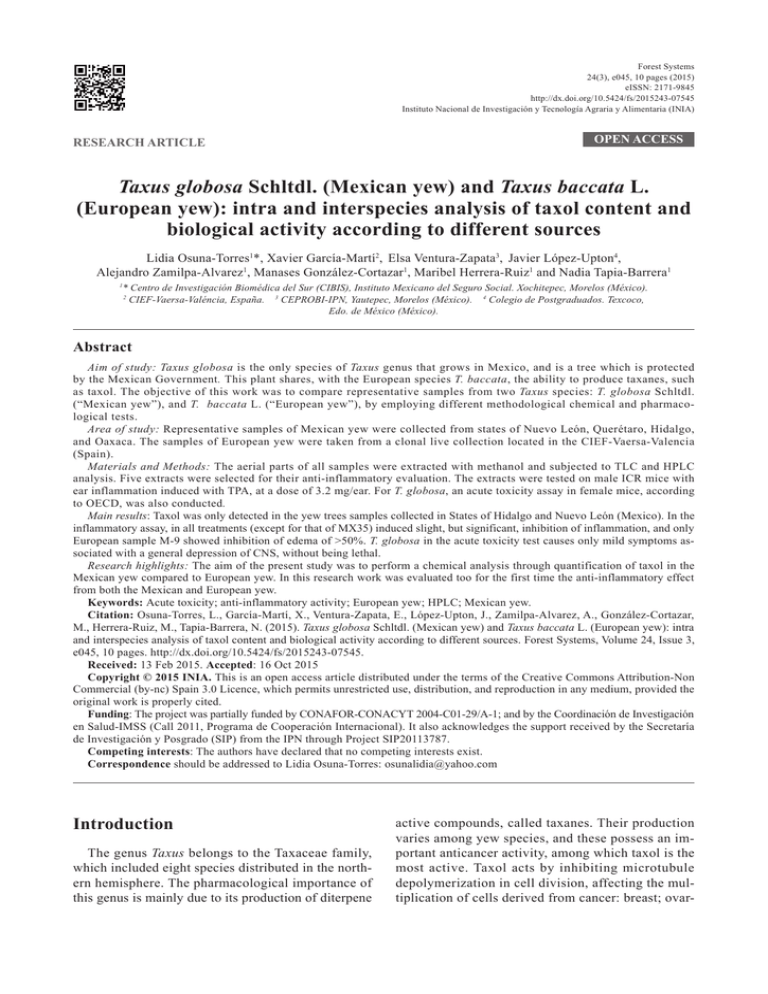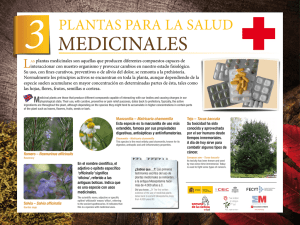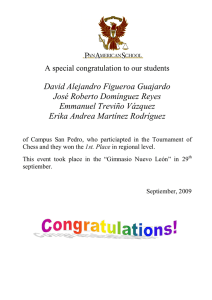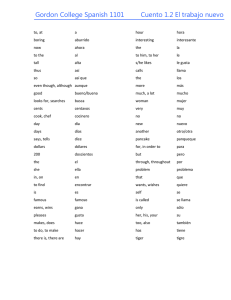Taxus globosa Schltdl. (Mexican yew) and Taxus baccata L
Anuncio

Forest Systems 24(3), e045, 10 pages (2015) eISSN: 2171-9845 http://dx.doi.org/10.5424/fs/2015243-07545 Instituto Nacional de Investigación y Tecnología Agraria y Alimentaria (INIA) RESEARCH ARTICLE OPEN ACCESS Taxus globosa Schltdl. (Mexican yew) and Taxus baccata L. (European yew): intra and interspecies analysis of taxol content and biological activity according to different sources Lidia Osuna-Torres1*, Xavier García-Martí2, Elsa Ventura-Zapata3, Javier López-Upton4, Alejandro Zamilpa-Alvarez1, Manases González-Cortazar1, Maribel Herrera-Ruiz1 and Nadia Tapia-Barrera1 1 * Centro de Investigación Biomédica del Sur (CIBIS), Instituto Mexicano del Seguro Social. Xochitepec, Morelos (México). 2 CIEF-Vaersa-Valéncia, España. 3 CEPROBI-IPN, Yautepec, Morelos (México). 4 Colegio de Postgraduados. Texcoco, Edo. de México (México). Abstract Aim of study: Taxus globosa is the only species of Taxus genus that grows in Mexico, and is a tree which is protected by the Mexican Government. This plant shares, with the European species T. baccata, the ability to produce taxanes, such as taxol. The objective of this work was to compare representative samples from two Taxus species: T. globosa Schltdl. (“Mexican yew”), and T. baccata L. (“European yew”), by employing different methodological chemical and pharmacological tests. Area of study: Representative samples of Mexican yew were collected from states of Nuevo León, Querétaro, Hidalgo, and Oaxaca. The samples of European yew were taken from a clonal live collection located in the CIEF-Vaersa-Valencia (Spain). Materials and Methods: The aerial parts of all samples were extracted with methanol and subjected to TLC and HPLC analysis. Five extracts were selected for their anti-inflammatory evaluation. The extracts were tested on male ICR mice with ear inflammation induced with TPA, at a dose of 3.2 mg/ear. For T. globosa, an acute toxicity assay in female mice, according to OECD, was also conducted. Main results: Taxol was only detected in the yew trees samples collected in States of Hidalgo and Nuevo León (Mexico). In the inflammatory assay, in all treatments (except for that of MX35) induced slight, but significant, inhibition of inflammation, and only European sample M-9 showed inhibition of edema of >50%. T. globosa in the acute toxicity test causes only mild symptoms associated with a general depression of CNS, without being lethal. Research highlights: The aim of the present study was to perform a chemical analysis through quantification of taxol in the Mexican yew compared to European yew. In this research work was evaluated too for the first time the anti-inflammatory effect from both the Mexican and European yew. Keywords: Acute toxicity; anti-inflammatory activity; European yew; HPLC; Mexican yew. Citation: Osuna-Torres, L., García-Martí, X., Ventura-Zapata, E., López-Upton, J., Zamilpa-Alvarez, A., González-Cortazar, M., Herrera-Ruiz, M., Tapia-Barrera, N. (2015). Taxus globosa Schltdl. (Mexican yew) and Taxus baccata L. (European yew): intra and interspecies analysis of taxol content and biological activity according to different sources. Forest Systems, Volume 24, Issue 3, e045, 10 pages. http://dx.doi.org/10.5424/fs/2015243-07545. Received: 13 Feb 2015. Accepted: 16 Oct 2015 Copyright © 2015 INIA. This is an open access article distributed under the terms of the Creative Commons Attribution-Non Commercial (by-nc) Spain 3.0 Licence, which permits unrestricted use, distribution, and reproduction in any medium, provided the original work is properly cited. Funding: The project was partially funded by CONAFOR-CONACYT 2004-C01-29/A-1; and by the Coordinación de Investigación en Salud-IMSS (Call 2011, Programa de Cooperación Internacional). It also acknowledges the support received by the Secretaría de Investigación y Posgrado (SIP) from the IPN through Project SIP20113787. Competing interests: The authors have declared that no competing interests exist. Correspondence should be addressed to Lidia Osuna-Torres: [email protected] Introduction The genus Taxus belongs to the Taxaceae family, which included eight species distributed in the northern hemisphere. The pharmacological importance of this genus is mainly due to its production of diterpene active compounds, called taxanes. Their production varies among yew species, and these possess an important anticancer activity, among which taxol is the most active. Taxol acts by inhibiting microtubule depolymerization in cell division, affecting the multiplication of cells derived from cancer: breast; ovar- 2 Lidia Osuna-Torres, Xavier García-Martí, Elsa Ventura-Zapata, Javier López-Upton, Alejandro Zamilpa-Alvarez, et al. ian; lung, and Kaposi sarcoma (Schiff et al., 1979; Schiff & Horwitz, 1980; Legha et al., 1990; O’Shaughnessy & Cowan, 1994; Arbuck & Blaylock, 1995). The following four species of the genus Taxus are distributed around the American continent: Taxus brevifolia Nutt.; Taxus canadensis Marshall.; Taxus floridana Nutt. ex Chapman., and Taxus globosa Schltdl. In México, Taxus globosa is known as “tejo mexicano”, “romerillo”, “granillo”, “palmira” or “tlascatl”, it is a dioecious tree 6-12 m in height, with a highly branched trunk and scaly light-brown bark. Young leaves are distributed spirally when mature and are flat and linear, up to 3.5 cm in length, with acute terminus and narrowed base on a short petiole, and with slightly rolled up margins, which dark green in the beam and lighter on the underside. Axillary male cones are located at the bottom of the twigs. Female cones occur in solitary fashion in the axils of the leaves, surrounded by various membranous bracts green in color. The seeds are ovoid and thicker, 6-7 mm in width, partially covered by a red fleshy aril (Zamudio, 1992; Zavala-Chávez et al., 2001; Zavala-Chávez, 2002). The flowering season takes place from January to March and fruits are borne from August to November; natural regeneration is based on seeds, which is artificially difficult, although the latter produces buds and stems, rendering vegetative propagation possible (Muñoz-Gutiérrez et al., 2009; RamirezSánchez et al., 2011). This species inhabits pine and fir forests, usually at the bottom of damp ravines at altitudes between 1,000 and 3,000 m (ZavalaChávez et al., 2001). This tree is distributed in the northeast, central, and southern Mexico, in the states of Tamaulipas, Nuevo León (where populations are larger), San Luis Potosí, Querétaro, Hidalgo, Veracruz, Oaxaca, and Chiapas. Due to the importance of this genus as a producer of active metabolites with pharmacological activity and its ecological relevance, the present research had as its objective the comparison of the concentration of taxol in the Mexican yew (T. globosa) with that of the European yew (T. baccata ). In addition, the aim of the investigation was to evaluate the anti-inflammatory effect of the methanol extract of samples of these plants collected in different places in Mexico and Europe, by using ear edema induced in mice with the 12-O-TetradecanoylPhorbol-13-Acetate (TPA) technique, selected by High-performance liquid chromatography (HPLC) according to its largest metabolic content. Finally, a test was performed of the acute toxicity classes (Organization for Economic Cooperation and Development [OECD]) of the meth- Forest Systems anol extract of T. globosa (Mexican yew). Owing to its biological characteristics, this tree is considered under the official conservation status of species subject to special protection (in the Norma Oficial Mexicana NOM-059-SEMARNAT, 2010. Thus, this species required research studies for protection, propagation, preservation, and cultivation (ZavalaChávez, 2002). Chemical studies of the species have been conducted mainly from specimens collected in the state of Hidalgo, without published data from other parts of the neither country, nor comparative studies among sites and, to our knowledge, there are no reports of ontogenetic and seasonal assessment on this tree. Taxol production has been reported in the cortex (0.0085%), leaves (0.0130%), and stem (0.0064%) of T. globosa, with greater taxol accumulation in leaves than in cortex (Soto et al., 2000). Also, other secondary metabolites have been identified, such as β-sitosterol, β-sitosterol-β-D-glucosidase, vanillic acid, and as per acetyl taxane denominated 5α, 7β, 9α, 10β, 13α-Penta-acetoxy-4(20), 11-Taxadiene-(7β-Acetoxy-Taxusin, 2) (Guerrero et al., 2000). In The Netherlands, van Rozendaal et al., (2000) reported the production of taxol and related taxanes in Taxus species, which include T. globosa as a species with highest content, not only of taxol, but also its precursors, which easily can be chemically bioconverted into cultures of T. baccata L. (Bentebibel et al., 2005), Taxus canadensis (Nikolakakis et al., 2000), in the hybrid Taxus media (Taxus baccata x Taxus cuspidata) (Bonfill et al., 2003) and Taxus wallichiana Zucc., (Navia-Osorio et al., 2002; van Rozendaal et al., 2000). On the other hand, T. baccata is known as “European yew”, and it is a dioecious evergreen tree that reaches 20 m in height, is broad, pyramidal, with horizontal or pendant-like branches, especially in the termination. The bark is gray-brown. The leaves measure 10 ± 30 ± 1.5-3 mm, are somewhat leathery, dark green on the beam and yellowish green on the underside; helically arranged on the branches, although they tend to be found on the same plane; are linear, flat, or slightly curled at the edge, and end in a cornea tip and have a short petiole. The flowers are unisexual, small, greenish, and solitary. The male cones appear in the axils of the leaves; they are globose, with 6-14 peltate scales, each with 4-8 pollen sacs. The seed, 6-7 mm, is oval and is mostly covered by a fleshy disk, aryl, which opens at the top; going from green to red at maturity. It blooms between March and April. The yew lives mainly in cool, moist, shady slopes and ravine sites, and stands the cold well, but in late December 2015 • Volume 24 • Issue 3 • e045 Taxus globosa Schltdl. and Taxus baccata L.: taxol content and biological activity frosts; it grows preferably in calcareous soils (Cortés et al., 2000). Given the importance of the species, preservation of the yew has been a priority: germplasm banks have been developed and conservation programs have been implemented, mainly through living clonal collections, one located at the “Forestry Research and Experimentation Center -CIEF of the Valencian Community (Spain) (GarciaMartí, 2006). Materials and Methods Selection of samples of Taxus globosa and T. baccata propagation through clonation of individuals from West Europe native populations. In Table 2, the populations and origin of the samples selected for study are depicted. Collection and drying of Taxus globosa and T. baccata plant material At each locality, dominant and healthy trees from both sexes were selected. The plant material (leaves and stems) were stored during the collection time in sealed bags duly labeled with information on habitat, geographic area, sex and, when the sex cannot be distinguished (a juvenile tree), it was designated as indefinite (IND). Sample collections from several trees of the same area were termed a bulk sample (MIX). Foliage in situ was identified as females, males, and juvenile trees, and a sample up to 500 g fresh weight of each locality was obtained. Fresh plant material was dried at room temperature and under dark conditions to obtained Dry Weight (DW) (Figure 2). Chemical analysis of the Taxus globosa and T. baccata samples The dried and ground plant materials (2 g DW) of the collected samples were subjected to an extraction process by maceration with methanol (20 mL, 24 h). Filtration of the liquid extract and solvent elimination 24°0’0”N The aerial parts of T. globosa material were collected during the month of October 2011 at eight locations, which correspond to three northwestern Mexican states: Nuevo León; Querétaro, and Hidalgo, which is where the greater presence of the Mexican yew occurs, and in one southwestern state, Oaxaca (Figure 1). Samples were qualified for identification and chemical analysis. In Table 1, the main characteristics from the collected specimens are mentioned. T. baccata samples were collected from the clonal bank located in the Forestry Research and Experimentation Center during October 2011 (the same season as the T. globosa samples). The donor trees are individuals from both sexes and are 15-20 years old. They were originally obtained via vegetative 3 21°0’0”N GOLFO DE MÉXICO 18°0’0”N 1. La Yerbabuena 2. La Encantada 3. La Tinaja 4. Cañada Los Granadillos 5. Cañada de Agua Fría 6. Cañada Los Ayacahuites 7. Cañada de Torres OCÉANO PACÍFICO 160 80 0 105°0’0”W 160 kilómetros 102°0’0”W 99°0’0”W 96°0’0”W 93°0’0”W Figure 1. Geographical location of the sampling zones in Mexico of T. globosa. Forest Systems December 2015 • Volume 24 • Issue 3 • e045 4 Lidia Osuna-Torres, Xavier García-Martí, Elsa Ventura-Zapata, Javier López-Upton, Alejandro Zamilpa-Alvarez, et al. Table 1. Identification of Taxus globosa samples Identification Clasification Description MX1 MX2 MX3 MX4 MX5 MX6 MX7 MX8 MX9 MX10 MX11 MX12 MX13 MX14 MX15 MX16 MX17 MX18 MX19 MX20 MX21 MX22 MX23 MX24 MX25 MX26 MX27 MX28 MX29 MX30 MX31 MX32 MX33 MX34 MX35 AYA 43 AYA 24B YBMIX AYAMIX AYA 39 YB 3 MA 3 GRA 3 GRA 2 QRO. IND. MA 1 GRA MIX + IND. GRA 4 YB 2 Ti 3 YB I MA 5 OAX MIX Ti MIX Ti 5 QRO IND. MA MIX ENC YB 4 GRA 5 Ti 2 Ti 1 AYA 53 QRO. IND. AYA 40 Ti 4 AYA T Ti 6 MA 2 NVO LEON IND. Mature tree, Mineral El Chico, Hidalgo Mature tree, Mineral El Chico, Hidalgo Bulk simple, La Yerbabuena, Gral. Zaragoza, Nuevo León Bulk sample, Mineral El Chico, Hidalgo Mature tree, Los Ayacahuites, Mineral El Chico, Hidalgo Mature tree, Gral. Zaragoza, Nuevo León Mature tree, La Máquina, Gral. Zaragoza, N.L. Mature tree, Los Granadillos, Pinal de Amoles, Querétaro Mature tree, Los Granadillos, Pinal de Amoles, Querétaro Juvenile tree, Los Granadillos, Pinal de Amoles, Querétaro Mature tree, La Máquina, Gral. Zaragoza, N.L. Bulk simple, Los Granadillos, Pinal de Amoles, Querétaro Mature tree, Los Granadillos, Pinal de Amoles, Querétaro Mature tree, La Yerbabuena, Gral. Zaragoza, Nuevo León Mature tree, La Tinaja, Gral. Zaragoza, Nuevo León Male mature tree, La Yerbabuena, Gral. Zaragoza, Nuevo León Mature tree, La Máquina, Gral. Zaragoza, N.L. Bulk sample, Santa María Yavesía, Oaxaca Bulk simple, Gral. Zaragoza, Nuevo León Mature tree, La Tinaja, Gral. Zaragoza, Nuevo León Juvenile tree, Los Granadillos, Pinal de Amoles, Querétaro Bulk simple, La Máquina, Gral. Zaragoza, Nuevo León Mature tree, La Encantada, Gral. Zaragoza, Nuevo León Mature tree, La Yerbabuena, Gral. Zaragoza, Nuevo León Mature tree, Los Granadillos, Pinal de Amoles, Querétaro Mature tree, La Tinaja, Gral. Zaragoza, Nuevo León Mature tree, La Tinaja, Gral. Zaragoza, Nuevo León Mature tree, Mineral El Chico, Hidalgo Juvenile tree, Los Granadillos, Pinal de Amoles, Querétaro Mature tree, Mineral El Chico, Hidalgo Mature tree, La Tinaja, Gral. Zaragoza, Nuevo León Mature tree, Los Ayacahuites, Mineral El Chico, Hidalgo Mature tree, La Tinaja, Gral. Zaragoza, Nuevo León Mature tree, La Máquina, Gral. Zaragoza, Nuevo León Juvenile tree, Gral. Zaragoza, Nuevo León Table 2. Identification and origin of Taxus baccata samples Identification Clasification M-1 M-2 M-3 M-4 M-5 M-6 M-7 M-8 M-9 M-10 M-11 M-12 M-13 M-14 M-15 M-17 M-18 M-19 ESTRY PM SM LEB 1 AIX 4 AIT7 BE12 PU1 ROP6 VALD CA19 SAF2 EST ALF2 BOCC TIGG TEJ GAL Forest Systems Description Mature tree. Female. Estry. (Normandy-France) Mature tree. Male Pumarin (León-Spain) Mature tree. Male. (Asturias-Spain) Mature tree. Female. Lebeña. (Cantabria-Spain) Mature tree. Male. Aixortà (Alacant-Spain) Mature tree. Male. Aitana (Alacant-Spain) Mature tree. Female. Bèrnia (Alacant-Spain) Mature tree. Female. Ropé (Valencia-Spain) Mature tree. Female. Ropé (Valencia-Spain) Mature tree. Female. (SC Valdueza) (León-Spain) Mature tree. Female. Espadà (Castelló-Spain) Mature tree. Male. Safor (Valencia-Spain) Mature tree. Female. Estrela (Portugal) Mature tree. Male. Alfaro (Alacant-Spain) Mature tree. Male. Bocca matare (Cerdeña-Italia) Mature tree. Male. Tiggidin (Riff-Morroco) Mature tree. Male. Alfaro (Alacant-Spain) Mature tree. Male. Galceran (Castelló-Spain) December 2015 • Volume 24 • Issue 3 • e045 Taxus globosa Schltdl. and Taxus baccata L.: taxol content and biological activity a) b) 5 the researcher. All experiments were conducted in accordance with the Federal Regulations for Animal Experimentation and Care (Ministry of Agriculture, NOM-062-ZOO-1999, México). Minimal number of animals and duration of observation required to obtain consistent data were employed. Anti-inflammatory activity of the methanol extracts of Taxus globosa and T. baccata Figure 2. Collection of yew trees: a) Mexican yew grown in the state of Nuevo León (Mexico), b) European yew grown in the clonal bank of the Forestry Research and Experimentation of Valencia (Spain). were performed by distillation under reduced pressure and dried under high vacuum (0.02 mbar), and the yields of each extract were obtained. The methanol extract of the collected samples was analyzed by Thin-layer chromatography (TLC) in order to make a comparison of the chemical composition of these samples. Plates packed with silica gel 60 were used (Merck, 6-cm in length), which were eluted in dichloromethane/methanol 95:5. Komarowsky reagent was utilized as chemical developer. Taxol ® was employed as chromatographic reference. High performance liquid chromatography (HPLC) analysis of the extracts was performed on a Waters chromatographic system equipped with an Alliance separation module and a 2995 Diode Array Detector. Reverse phase column (RPC18 Supersphere, 120 × 4 mm, 5 µm) was used for chemical separation. The mobile phase consisted of a gradient system constituted of water (solvent A) and acetonitrile (solvent B) as follows: 100:0 (0-2 min); 80:20 (3-6 min); 70:30 (7-10 min); 60:40 (11-16 min); 40:60 (1718 min), and 100:0 (19-20 min). Flow rate was 1 mL/ min and injection volume was 20 µL. A wavelength range of 200-400 nm was utilized by setting the analysis at 220 nm. A commercial sample of Taxol® was used as a reference (Tapia et al., 2013). Animals Male and female ICR mice with a weight of 35 g were used. All animals were purchased from Harlan Mexico (Mexico, D.F.), and maintained in an animal house for 3 weeks with a 12-h/12-h light-dark cycle and free access to water and food (pellets, Harlan). Three days prior to the initiation of testing, the animals were conditioned to the laboratory environment and to Forest Systems The animals were divided into groups (n = 7; average weight, 35 g). These animals, under surgical anesthesia with Pentobarbital Sodium (55 mg Kg–1 by intraperitoneal [i.p.] pathway), were treated as follows: left ear (control) of each mouse with 10 μl of methanol administered on both sides of the ear, while treatments were applied on right ear, 10 μl and also on both sides of the ear. The dose applied was 3.2 mg/ear, and these were applied from the following extracts of T. globosa; MX2 (AYA 24B); MX5 (AYA39), and MX35 (NVO LEON IND), and from T. baccata (M-1 Normandy and M-9 Valencia). The positive control group received 20 μl of Indomethacin 1 mg/ear, while the negative control animals were administered with only 20 μl of vehicle (methanol). After 15 min, was applied to the right ear, 20 μl of TPA (2.5 μg/ear), all treatments were applied in the internal and in the external mouse ear (10 µl to each side). After 4 h, the animals were sacrificed by overexposure to anesthetic and circular center sections (6-mm in diameter) of both ears were taken to determine the weight difference as a measurement of inflammation; subsequently, the percentage of edema inhibition was calculated, using the following expression: Inhibition (%) = [Dw control – Dw treatment]×100 Where Dw = wt − wnt; wt is the weight of the section of the treated ear, and wnt is the weight of the section of the non-treated ear. Data were analyzed with one-way Analysis of variance (ANOVA) and the Dunnet test and were compared with the group receiving methanol as vehicle and TPA, employing a significance level of 95%. Acute toxicity model Oral acute toxicity refers to the adverse effects that occur after oral administration of a single dose of a substance, or multiple doses for 24 h. This test was conducted according to the guidelines established by the Organization for Economic Cooperation and Development (OECD, 2001). For this test, three ICR- December 2015 • Volume 24 • Issue 3 • e045 6 Lidia Osuna-Torres, Xavier García-Martí, Elsa Ventura-Zapata, Javier López-Upton, Alejandro Zamilpa-Alvarez, et al. Results strain female mice were used, with an average weight of 26 g for each group; the mice were acclimatized under regular laboratory conditions. Food was withheld for 1 h prior to treatment administration. Treatments were administered orally to each group with different doses of the methanol extract of T. globosa, which were 50, 300, and 500 mg Kg–1, and the fourth group received a solution of Tween 20 at 1% (100 μl/10 g, control group). Subsequently, toxicity assessment was performed by observation of the behavioral parameters included in the neurotoxicity of the Irwin primary observation test (Sadraei et al., 2006) at 10 and 30 min, and at 2, 3, and 24 h. These parameters included the following: a) abdominal contortion; b) bristly hairs (possible action on Autonomic Nervous System (ANS) by sympathetic stimulation through β-adrenergic receptors); c) palpebral ptosis (sign of central depression); d) motor impairment (an increase indicates stimulation of the Central Nervous System (CNS) and depression predicts a decrease of this organ); e) hypothermia’s (hypothermia, CNS depression); f) loss of muscle tone, CNS depression; g) tremors (CNS depression); h) limb paralysis (its presence is indicative of CNS depression); i) salivary secretion (possible action on SNA by sympathetic (α-adrenergic receptors) or parasympathetic (muscarinic receptors) stimulation; j) seizures (reflecting a CNS stimulation), and k) constipation and, ultimately, death (in case of these being present). The species T. globosa was collected in different geographical areas of Mexico, noting, in general, areas in the north, central, and south zone. At each of these locations, the species was observed as healthy for all ages (matures, juvenile, and regeneration) in trees of both sexes, female and male, corroborating that reported by Muñoz-Gutiérrez et al., (2009), that is, the high rate of reproduction of the Mexican yew, this due to the forest protection that currently possesses the yew stands in Mexico (Figure 2). Extracts and Analysis by TLC of Samples of Taxus globosa and T. baccata Extracts of both samples of Mexican as well as European yew were obtained; their yields fluctuated between 7 and 16% and between 3 and 4%, respectively. The TLC profile allowed observing chemical similarity in all samples, with only the concentration varying of some medium-polarity compounds (Figure 3). The fingerprint comparison of samples from T. globosa: MX2 (AYA 24B), MX5 (AYA 39), and MX35 (NVO LEON IND) with samples from T. baccata: M-1 (Normandy) and M-9 (Valencia) indicated that a major concentration of taxol was detected in the yew trees collected in the Central area of Mexico (Hidalgo State) (Table 3) (Figures 4.2A, 4.2B, 4.3A, and 4.3B). a) b) c) Figure 3. Thin layer chromatographic comparison of Taxus samples: a) and b) corresponds with Mexican samples MX1 to MX35 and c) corresponds with European samples M1-M13. Silica gel plates of Merck 60 were used, which were eluted in a mix of dichloromethane/methanol 95:5. UV 254 nm and Komarowsky reagent and were used as detection methods Forest Systems December 2015 • Volume 24 • Issue 3 • e045 Taxus globosa Schltdl. and Taxus baccata L.: taxol content and biological activity 7 Table 3. Taxol content in yew sample Samples Yield (mg) in 2 g DW plant Taxol concentration mg g –1 DW 192,7 212,8 325 0,081 0,082 0,0025 0,0057 0,0043 not detectable not detectable MX2 (AYA 24B) MX5 (AYA 39) MX35 (NVO LEON IND) M-1(NORMANDY-FRANCE) M-9 (VALENCIA-SPAIN) The European yew (leaves) did not exhibit having accumulated detectable concentrations of taxol (Table 3). However, this species (T. baccata) produces an accumulation of a phenolic compound at 11.443 min (Uv λ max = 280 nm) (Figures 4.4A and 4.4B). Anti-inflammatory Activity Different samples of extracts of Taxus were evaluated in the inflammation test, in which it was shown that doses of 3.2 mg/ear of treatments from T. globosa: MX2 and MX5, induced a significant decrease of ear edema induced by the phorbol ester (TPA) in comparison with the group with vehicle (p <0.05), these results representing >30% of anti-inflammatory activity. In treatments from T. baccata, only the extract of the M-9 sample demonstrated highest activity, with an edema inhibition percentage of 53%, this meaning that this extract diminished the inflammation level from 11.5 mg to 5.4 mg. The extract from the M-1 sample from the same species not exhibit anti-inflammatory activity (Table 4). Table 4. Anti-inflammatory activity of Taxus globosa and T. baccata in the test with TPA-induced inflammation Yew samples (3.2 mg/ear) Inhibition Edema (mg) of Edema (%) MX2 (AYA 24B) 7.46 ± 1.9* MX5 (AYA 39) 7.04 ± 1.6* MX35 (NVO LEON IND) 8.48 ± 1.0 M-1 (NORMANDY-FRANCE) 7.56 ± 1.4* M-9 (VALENCIA-SPAIN) 5.40 ± 0.89* Indomethacin(1 mg/ear) 2.22 ± 0.94* Vehicule 11.50 ± 0.77 35,13 38,78 26,26 34,27 53.04* 80,65 0 Note: Values are mean ± S.D. (n = 7 mice); * p <0.05, in comparison with vehicle group. ANOVA with a Dunnet test. Figure 4. Chromatographic comparison of standards taxanes (1A) with the Mexican samples MX2 (2A), MX5 (3A) and with the European sample M-9 (4A). Forest Systems December 2015 • Volume 24 • Issue 3 • e045 8 Lidia Osuna-Torres, Xavier García-Martí, Elsa Ventura-Zapata, Javier López-Upton, Alejandro Zamilpa-Alvarez, et al. Acute Toxicity Tests of Taxus globosa The concentration of taxanes varies among the different species of the Taxus genus, and the accumulation of these bioactive diterpenoids depends on the organs analyzed. The European yew is one of the species with many reports on its chemistry, biology, and traditional uses, including its use as urinary tract anti-inflammatory, without this property having been scientifically proven to date and there has been no scientific evidence supporting this property (Blanco et al., 2008). The taxanes described in T. baccata (taxol, 10-deacetylbaccatin III, or baccatin III) were found principally in the species’ bark. Although the leaves of T. globosa produce significant amounts of these taxanes, there are few pharmacological reports on this Mexican yew. To our knowledge, this is the first comparative study between the European and Mexican species of Taxus from a chemical and pharmacological standpoint. In both cases, the methanol extract was utilized to perform the chromatographic comparison. In general, the specimens of T. globosa produced a higher concentration and quantity of taxane derivatives, including taxol, than T. baccata specimens. Furthermore, the concentration of these taxanes was analyzed in several species of both (35 for T. globosa, and 18 for T. baccata) recollected in different areas in Mexico and in Europe. In both cases, the chemical composition varied with respect to the specimen area and the specific yew tree sampled. Quantitative analysis (taxol content) of samples from T. globosa collected in October indicated that this plant produces concentrations of the same order of magnitude but at a lesser concentration (0.0025, 0.0043, and 0.0057 mg g –1 DW) than those reported by SotoHernández et al. (2011) (0.0163-0.1103 mg g–1 DW) in trees studied during the months of January and Febru- Oral administration of doses of 300 and 500 mg Kg –1, caused some symptoms classified as mild (+) and these are associated with general CNS depression, including bristly hairs, palpebral ptosis, decrease in motor impairment, hypothermia, and tremors. These symptoms occurred at 10, 30 min, and 2 h after administration of the treatments. At 24 h, these animals exhibited similar behavior to that of the vehicle group. The lower dose did not cause any symptoms or changes in the behavior of the mice. This indicates that it acts as a CNS depressant; however according to the rules of the OECD, no acute toxicity is induced by the extract, because no death was induced (Table 5). Discussion The genus Taxus includes trees growing in specific regions of the American, Eurasian, and African continents. Plants of this genus produce a particular type of compound, taxanes, which are diterpene compounds. Taxol is of particular importance due to its significant anti-cancerigenous activity; its natural accumulation is mainly in the cortex, although it is also stored in the aerial parts in a few species such as T. globosa and T. chinensis. In addition to the highly documented anti-cancer effect of the taxol, it has also been reported that this substance was able to decrease the effect of vascular inflammation in a model of lung injury induced by intratracheal administration of Lipopolysaccharide (LPS) (Mirzapoiazova et al., 2007). Table 5. Behavioral parameters associated with neuro-toxicity following administration of methanol extract of Taxus globosa Time Treatment Abdominal contortion Bristly hairs Palpebral ptosis Motor impairment Hypothermia’s Lost of muscle tone Tremors Limb paralysis Salivary secretion Seizures Death Others (Constipation) 10 min 30 min 2h 3h 24 h 1 2 3 4 1 2 3 4 1 2 3 4 1 2 3 4 1 2 3 4 – – – – – – – – – – – – – – – – – – – – – – – – – – + + – + – – – – – – + + – + + + – – – – – – – – – – – – – – – – – – – – – – – – – – – – – – – + – + – – – – – – – – + – – + – – – – – – – – – – – – – – – – – – – – – – – – – – – – – – – – + + + + – – – – – – – – + + + + – – – – – – – – – – – – – – – – – – – – – – – – – – – – – – – – – – – – – – – – – – – – – – – – – – – – – – – – – – – – – – – – – – – – – – – – – – – – – – – – – – – – – – – – – – – – – – – – – – – – – – – Legend: (+) Light, (++) Moderate (+++) Severe, (–) absence, (1) Vehicle, (2) 50 mg Kg–1 , (3) 300 mg Kg–1, and (4) 500 mg Kg–1 . Forest Systems December 2015 • Volume 24 • Issue 3 • e045 Taxus globosa Schltdl. and Taxus baccata L.: taxol content and biological activity ary, suggesting a seasonal fluctuation of taxol content in the Mexican yew. The absence of taxol was confirmed for European yew leaves (T. baccata); however, the presence was recorded of a compound with an 11.443-min retention time with the spectrophotometric characteristics (UV λ max = 280 nm) of a phenolic compound. In this research work, the anti-inflammatory effect was evaluated, to our knowledge for the first time, of both the Mexican and the European yew based on some reports indicating such a use. It was observed that the methanol extract of samples (MX2, MX5, and MX35) from T. globosa and sample M-1 from the French yew sample exert only a moderate anti-inflammatory effect (35.13, 38.78, 26.26, and 34.26% of inhibition, respectively), while the M-9 sample, deriving from trees located in Valencia, Spain, was able to inhibit ear edema above 50%. Such activity may be attributed to different taxol secondary metabolites, although the pharmacological effect is not comparable with other species with higher activity at lower doses (Muñoz et al., 2011), the anti-inflammatory effect of both yew species should not be discarded. It is possible that the effect level detected in the methanol extract of T. globosa is due to its chemical complexity and could be fractionated to enhance its effect. Finally, by means of the acute toxicity test based on OECD, it was demonstrated that the T. globosa extract does not cause toxic effects, although it does give rise to other general signs of CNS depression. These studies are aimed at the phytochemical study of samples with greatest biological activity, in order to isolate and identify the secondary metabolites responsible for the anti-inflammatory activity from both species: T. baccata and T. globosa. References Arbuck SG, Blaylock BA, 1995. Taxol: Clinical Results and Current Issues in Development. Taxol: Science and Applications. Suffness, M. (Ed.). CRC Press, Boca Raton, Florida. Pp. 379-415. Blanco E, Vasco F, Abella I, Cortés S, 2008. Tejo y cultura: de la tradición etnobotánica a la farmacología científica. II Jornades sobre el Teix a la Mediterrania Occidental 4: 63-78. Bentebibel S, Moyano E, Palazon J, Cusido RM, Bonfill M, Eibl R, Pinol MT, 2005. Effects of immobilization by entrapment in alginate and scale-up on taxol and baccatin III production in cell suspension cultures of Taxus baccata. Biotechnol Bioeng 89(6): 647-55. http://dx.doi. org/10.1002/bit.20321. Bonfill M, Palazón J, Cusidó RM, Joly S, Morales C, Piñol, MT, 2003. Influence of elicitors on taxane production and 3-hydroxy-3-methylglutaryl coenzyme A reductase activ- Forest Systems 9 ity in Taxus media cells. Plant Physiology and Biochemistry 41: 91-96. http://dx.doi.org/10.1016/S09819428(02)00013-X. Cortés S, Vasco F, Blanco E, 2000. El libro del tejo (Taxus baccata L.). Un proyecto para su conservación. ARBA. Madrid. 336 pp. García-Martí X, 2006. Producción de material forestal de Taxus baccata L. destinado a planes de conservaciòn. En “El tejo en el Mediterráneo Occidental”. SERRA, L. (ed.). Generalitat Valenciana-Conselleria de Territori i. Habitatge. CAM, Spain. Guerrero B, Castillo J, Aguilar MI, Delgado G, 2000. 5α, 7β, 9α, 10β, 13α-pentaacetoxy-4(20), Taxadieno (7β-acetoxyTaxusin) and Other Constituents from the Bark of the Mexican Yew, Taxus globosa (Taxaceae). Revista de la Sociedad Química de México 44:2:148-150. Legha SS, Ring S, Papadopoulos N, Raber M, Benjamin RS, 1990. A phase II trial of Taxol in metastatic melanoma. Cancer 65: 2478. Mirzapoiazova T, Kolosova IA., Moreno, L., Sammani S, Garcia JG,Verin AD, 2007. Suppression of endotoxininduced inflammation by taxol. Eur Respir J 30: 429-435. http://dx.doi.org/10.1183/09031936.00154206. Muñoz-Gutiérrez L, Vargas-Hernández JJ, López-Upton J, Soto-Hernández M, 2009. Effect of cutting age and substrate temperature on rooting of Taxus globosa. New Forest 38: 187-196. http://dx.doi.org/10.1007/s11056-0099139-6. Muñoz O, Christen P, Cretton S, Backhouse N, Torres V, Correa O, Costa E, Miranda H, Delporte C, 2011. Chemical study and anti-inflammatory, analgesic and antioxidant activities of the leaves of Aristotelia chilensis (Mol.) Stuntz, Elaeocarpaceae. J Pharm Pharmacol 63: 849-59. http://dx.doi.org/10.1111/j.2042-7158.2011.01280.x. Navia-Osorio A, Garden H, Cusidó RM, Palazón J, Alfermann AW, Pinol MT, 2002. Production of paclitaxel and baccatin III in a 20-L airlift bioreactor by a cell suspension of Taxus wallichiana. Planta Med 68(4): 336-40. http:// dx.doi.org/10.1055/s-2002-26739. Nikolakakis A, Caron G, Cherestes A, Sauriol F, Mamer O, Zamir LO, 2000. Taxus canadensis abundant taxane: Conversion to paclitaxel and rearrangements. Bioorg Med Chem 8(6): 1269-1280. http://dx.doi.org/10.1016/S09680896(00)00056-0. Norma Oficial Mexicana NOM-059-SEMARNAT, 2010. Protección ambiental-Especies nativas de México de flora y fauna silvestres-Categorías de riesgo y especificaciones para su inclusión, exclusión o cambio-lista de especies en riesgo. OECD 2001. Guideline for testing of Chemicals. Acute oral toxicity-Up-and Down procedure. O’Shaughnessy JA, Cowan KH, 1994. Current status of Paclitaxel in the treatment of breast cancer. Breast Cancer Res Treat 33: 27-37.http://dx.doi.org/10.1007/BF00666068. Ramírez-Sánchez SE, López-Upton J, García-De los Santos G, Vargas-Hernández JJ, Hernández-Livera A, AyalaGaray OJ, 2011. Variación morfológica de semillas de Taxus globosa Shltdl. provenientes de dos regiones geográficas de México. Rev Fitotecnia Mexicana 34: 93-99. December 2015 • Volume 24 • Issue 3 • e045 10 Lidia Osuna-Torres, Xavier García-Martí, Elsa Ventura-Zapata, Javier López-Upton, Alejandro Zamilpa-Alvarez, et al. Sadraei H, Asghari G, Zeinodin M, 2006. Evaluation of systemic effect of Pycnocycla spinosa extract in mice using Irwin test. Research in Pharmaceutical Sciences 1:22-29. Schiff PB, Fant J, Horwitz SB, 1979. Promotion of microtubule assembly in vitro by taxol. Nature 277: 665-667. http://dx.doi.org/10.1038/277665a0. Schiff PB, Horwitz SB, 1980. Taxol stabilizes microtubules in mouse fibroblasts cells. Proc Natl Acad Sci 77: 15611565. http://dx.doi.org/10.1073/pnas.77.3.1561. Soto-Hernández M, López J, Vargas-Hernández JJ, MuñozGutiérrez, L, San Miguel R, 2011. Estado de conservación de Taxus globosa en Mexico. Span J Rural Develop 61-68. Soto M, Sanjurjó M, González MT, Cruz D, Giral F, 2000. El Tejo mexicano (Taxus globosa Schltdl.) potencial de su aprovechamiento en Taxol. Ciencia Ergo Sum 7(3): 277-279. Tapia N, Zamilpa A, Bonfill M, Ventura E, Cruz-Vega D, Del Villar A, Cruz-Sosa F, Osuna L, 2013. Effect of the culture medium and biotic stimulation on taxane production in Forest Systems Taxus globosa Schltdl. in vitro cultures. Act Physiol Plant 35 (12): 3447-3455. http://dx.doi.org/10.1007/s11738-0131380-0. van Rozendaal ELM, Lelyveld GP, van Beek TA, 2000. Screening of the needles of different yew species and cultivars for paclitaxel and related taxoids. Phytochemistry 53: 383-389. http://dx.doi.org/10.1016/S00319422(99)00094-1. Zamudio RS, 1992. Familia Taxaceae. In: Flora del Bajío y de Regiones Adyacentes. Instituto de Ecología. Pátzcuaro, Michoacán, México. Fascículo 9: 1-4. Zavala-Chávez F, 2002. Análisis demográfico preliminar de Taxus globosa Schltdl. en el Parque Nacional El Chico, Hidalgo, México. II: Población de juveniles y algunos datos de semillas. Ciencia Ergo Sum 9(2):177183. Zavala-Chávez F, Soto-Hernández M, Rodríguez-González MT, 2001. El Romerillo (Taxus globosa Schltdl.): Biología. Problemas y Perspectivas de Uso. Revista Chapingo Serie Horticultura 7(1): 77. December 2015 • Volume 24 • Issue 3 • e045









